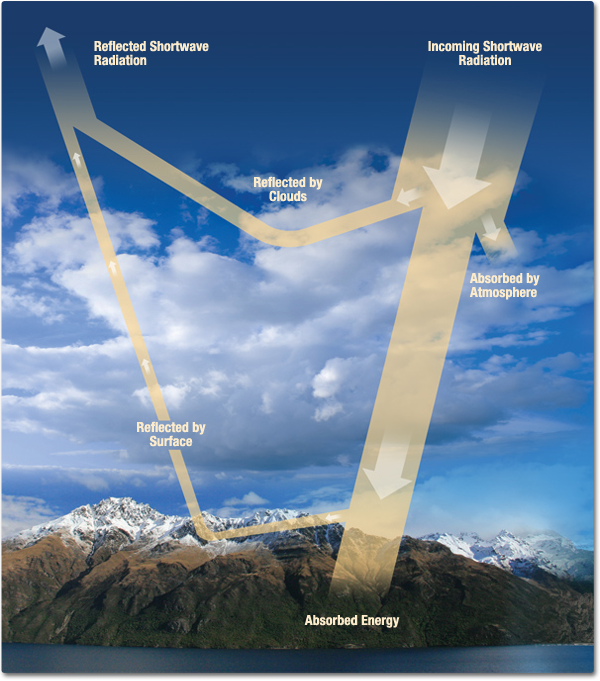Earth’s Radiation Budget
How the Earth stays warm has to do with the total amount of energy we receive from the sun (around 1366.5 W/m2 when measured in space, and the amount that actually makes it to the surface of Earth is estimated to be around 342 W/m2 on average. Once the energy makes it to the surface, it changes from short wave radiation to longwave radiation which is heat energy. Clouds, dark and light surfaces and greenhouse gases generally regulate the amount of energy that is held within our climate system.
The simple fact is that without greenhouse gases, the earth would be frozen just below zero degrees fahrenheit. The combined effects of energy absorbed, long term natural cycles, short term natural variability, oceans, clouds, land and greenhouse gases are the major regulators of the Earth’s radiation budget.
The energy entering, reflected, absorbed, and emitted by the Earth system are the components of the Earth’s radiation budget. Based on the physics principle of conservation of energy, this radiation budget represents the accounting of the balance between incoming radiation, which is almost entirely solar radiation, and outgoing radiation, which is partly reflected solar radiation and partly radiation emitted from the Earth system, including the atmosphere. A budget that’s out of balance can cause the temperature of the atmosphere to increase or decrease and eventually affect our climate. The units of energy employed in measuring this incoming and outgoing radiation are watts per square meter (W/m2).

INCOMING SOLAR RADIATION
Incoming ultraviolet, visible, and a limited portion of infrared energy (together sometimes called “shortwave radiation”) from the Sun drive the Earth’s climate system. Some of this incoming radiation is reflected off clouds, some is absorbed by the atmosphere, and some passes through to the Earth’s surface. Larger aerosol particles in the atmosphere interact with and absorb some of the radiation, causing the atmosphere to warm. The heat generated by this absorption is emitted as longwave infrared radiation, some of which radiates out into space.
ABSORBED ENERGY
The solar radiation that passes through Earth’s atmosphere is either reflected off snow, ice, or other surfaces or is absorbed by the Earth’s surface.

Emitted LONGWAVE Radiation
Heat resulting from the absorption of incoming shortwave radiation is emitted as longwave radiation. Radiation from the warmed upper atmosphere, along with a small amount from the Earth’s surface, radiates out to space. Most of the emitted longwave radiation warms the lower atmosphere, which in turn warms our planet’s surface.

GREENHOUSE EFFECT
Greenhouse gases in the atmosphere (such as water vapor and carbon dioxide) absorb most of the Earth’s emitted longwave infrared radiation, which heats the lower atmosphere. In turn, the warmed atmosphere emits longwave radiation, some of which radiates toward the Earth’s surface, keeping our planet warm and generally comfortable. Increasing concentrations of greenhouse gases such as carbon dioxide and methane increase the temperature of the lower atmosphere by restricting the outward passage of emitted radiation, resulting in “global warming,” or, more broadly, global climate change.

Credit: NASA/Goddard Space Flight Center Scientific Visualization Studio
RADIATION AND THE CLIMATE SYSTEM
For scientists to understand climate change, they must also determine what drives the changes within the Earth’s radiation budget. The Clouds and the Earth’s Radiant Energy System (CERES) instrument aboard NASA’s Aqua and Terra satellites measures the shortwave radiation reflected and longwave radiation emitted into space accurately enough for scientists to determine the Earth’s total radiation budget. Other NASA instruments monitor changes in other aspects of the Earth’s climate system—such as clouds, aerosol particles, and surface reflectivity—and scientists are examining their many interactions with the radiation budget.
Source: NASA
The next two illustrations are plots of the so-called radiation budget that balances incoming with outgoing radiation, first in percents and then in power terms.


The reason for showing the above two illustrations is just to call attention to the complexities involved in the physics of the atmosphere. Various processes and interactions are involved in heating up the atmosphere. Changes in both short-term and long-term temperatures depend not only on adding a single heat-absorbing gas but on other factors that either exacerbate or mitigate the thermal state of the Earth’s air.
Source: NASA/GSFC

Source: UWSP

Source: NASA

